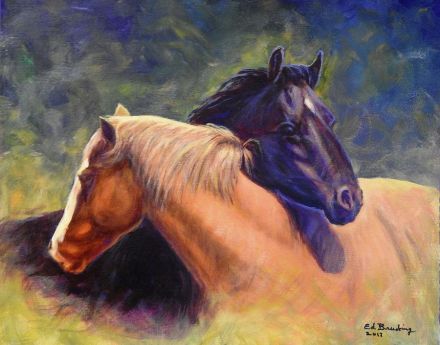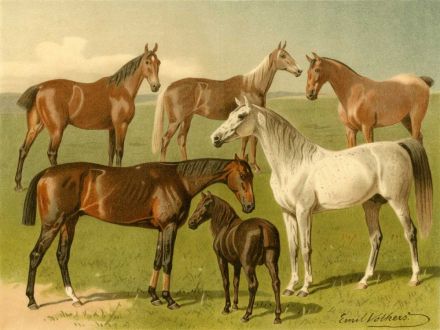Difference between revisions of "Horse Breeding (sage ability)"
Tao alexis (talk | contribs) |
m |
||
| Line 4: | Line 4: | ||
== Pedigree == | == Pedigree == | ||
| − | For game purposes, the pedigree of horses is simplified. Every horse is scaled according to its health, robustness, speed, courage and fertility. Health registers the resistance of the animal to disease and fatigue; robustness, the overall strength and endurance of the horse as a working animal; speed, its value as a racehorse; courage, its temperament when exposed to combat; and fertility, [[the ease with which it procreates]] and the chances that it will a positive mutation. | + | For game purposes, the pedigree of horses is simplified. Every horse is scaled according to its health, robustness, speed, courage and fertility. Health registers the resistance of the animal to disease and fatigue; robustness, the overall strength and endurance of the horse as a working animal; speed, its value as a racehorse; courage, its temperament when exposed to combat; and fertility, [[the ease with which it procreates]] and the chances that it will possess a positive mutation. |
All horses, wild or domestic, already have [[Horseback_Riding_(sage_study)#Breeds_.26_Size|specific characteristics relating to their type]]. These types are the results of thousands of years of breeding; any horse is, therefore, measured against its type with regards to its pedigree. Thus, the measure of a working horse's robustness is applied to a different template than that of a pony. | All horses, wild or domestic, already have [[Horseback_Riding_(sage_study)#Breeds_.26_Size|specific characteristics relating to their type]]. These types are the results of thousands of years of breeding; any horse is, therefore, measured against its type with regards to its pedigree. Thus, the measure of a working horse's robustness is applied to a different template than that of a pony. | ||
Revision as of 14:46, 20 March 2020
Enables skill in the assessment judgment and the practice of selective breeding of horses. The study incorporates the method by which specially desired characteristics in domesticated horses are improved through their offspring, granting also a superior skill in ensuring a healthy pregnancy and successful foaling. The character is able to recognize the pedigree of horses upon examination, determining with sight and skill those characteristics that make a specific horse a good candidate for breeding. This knowledge is then applied when inducing a stallion and a mare to couple and reproduce — not only so that their pre-existing traits can be shared by the offspring, but also to ensure the highest possible chance of a giving pairing producing a positive-mutation.
Pedigree
For game purposes, the pedigree of horses is simplified. Every horse is scaled according to its health, robustness, speed, courage and fertility. Health registers the resistance of the animal to disease and fatigue; robustness, the overall strength and endurance of the horse as a working animal; speed, its value as a racehorse; courage, its temperament when exposed to combat; and fertility, the ease with which it procreates and the chances that it will possess a positive mutation.
All horses, wild or domestic, already have specific characteristics relating to their type. These types are the results of thousands of years of breeding; any horse is, therefore, measured against its type with regards to its pedigree. Thus, the measure of a working horse's robustness is applied to a different template than that of a pony.
Each of the five characteristics above is rolled for on 4d6, the average of which is 14. Each point of deviation from 14 indicates a 1% deviation from the standard template that applies to each horse type. For example, a domestic pony has 1-10 hit points; this initial number indicates the pony's bodily units. If we roll on 4d4 and gain a result of 16, then the pony's health is 2% above normal; this does not increase the pony's hit points, but does make the pony 2% more resistant to disease. A similar result against the pony's robustness would enable a 2% greater load that could be hauled or carried; if applied to speed, the pony would be 2% faster; in battle, it's morale would be improved by 2%; and with regards to fertility, it would be 2% more likely to reproduce and 2% more likely to produce a mutation in its offspring.
This seems a slight adjustment; however, when applied to millions of domestic horses worldwide, remarkably slight improvements have the power to win races, permit a rider to survive a fight or can be applied a permanent adjustment in a horse type — the method by which wild horses were eventually bred to a type with 4+4 hit dice.
Mating
This formula enables the game to reproduce a wide distribution of specific horses, potentially adjusting a horse's price or giving a tremendous credence as to why persons might sincerely treasure their beloved horses. Breeding is therefore easily managed in game terms, since it is presumed that the horse breeder is fully aware of the horse's pedigree as described above. Therefore, the stallion and mare are selected; the resultant offspring will randomly assume the pedigree of one horse or the other — and in each case, the combined mutation % (d100) is rolled for the offspring. If the mutation occurs, then the highest two pedigree characteristics of the offspring will be raised by 1-2 points. If more than two pedigrees show as the highest number, then randomly roll to determine which two pedigrees are raised.
If "00" (or 100) is rolled on the mutation die, then the mutation is a negative. If so, two random pedigree characteristics (regardless of importance) are each lowered by 1 point.
Obviously, the bloodlines of stallions and mares must be kept clean. 2nd cousins will increase the chance of a negative mutation to 10%; 1st cousins, to 20%; and between siblings or direct ancestors to 40%. Normally, horses will not willingly mate between siblings and direct ancestors.
Example of Mating
A stallion with 18 health, 15 robustness, 9 speed, 10 courage and 16 fertility is mated with a mare whose like characteristics are 16h, 10r, 10s, 16c and 18f. We roll a 50% chance for each to determine the dominant partner in each characteristic, and find the dominant is the female, male, male, female, female. Thus, the offspring's characteristics are 16h, 15r, 9s, 16c and 18f — which, rolling randomly, chances to be markedly better than both parents.
The total chance of a mutation is 6% (2% from the male and 4% from the female). I did not roll a success. But had there been a successful mutation, the offspring's fertility would have been improved by 1-2 points; and likewise with either the offspring's health or courage (50% chance of each). If a negative mutation had been rolled, two random characteristics would have lost a point each.
The chance of a negative mutation is made lower than a positive because it is assumed poorly bred horses have been consistently culled from the breeding pool for millennia (and, with the help of magic, better than was done in human history).
Purchasing
If a horse is not purchased in a market, or if the number of horse references in a given market is less than 1, then the pedigree of a horse is rolled upon 4d6 without adjustments. For every full reference point, add +1 to the total rolled for each pedigree characteristic. Thus, if a given market were to have 4 or more reference points for horses, the average pedigree for each characteristic would be 4 pts. above normal. This assumes that the number of horses, and the ability of the character to discern good horses from poor, enables the character to find the better horses among the much larger population. For any other unskilled person purchasing horses in a larger market, the pedigree of the horse is not given this bonus.
A horse breeder will be able to examine the horse and know in advance the quality of what is being bought. It can then be decided if the purchase is desirable. Unless the seller is also a horse breeder, it is likely that the character will have some trouble haggling over the price, though this remains possible through role-play. A non-horse breeder will, if encouraged, drop their price at least 5% if the buyer is obviously a horsebreeder and the overall pedigree of the horse is less than 70 pts. combined.
Horse breeders can be commissioned to buy better horses, if others wish to spend a 10% fee over the value of the horse.
The very best horses are purchased at auction.
Bloodlines
Numerous horse breeds already exist, possessing a standardized pedigree that could be established through the list above. I have no specific intention of doing so, unless it is needed for a specific campaign I'm running. However, it is imaginably possible that characters, through true-breeding characteristics over a number of generations (where the stallion and mare have interchangeable characteristics so that it matters little from which the offspring takes its pedigree), could establish a unique or semi-unique bloodline. In which case, it would be sensible to establish specific coat colors and distinctive markings as the bloodline is established. This could probably be done ad hoc, with the player's input, since it would have little game effect.
See Horseback Riding

